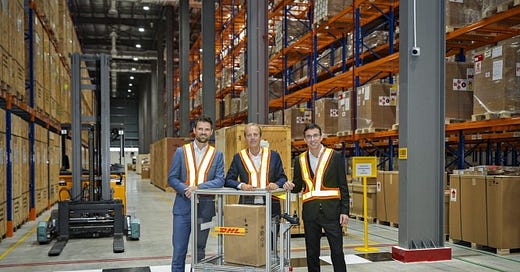🔐 From Manual Chaos to Smart Control: How Ricoh Europe & DHL Reinvented Supply Chain Operations
What the Smart Locker transformation teaches us about the reality of AI adoption, the fragility of digital trust, and the deep-rooted problems supply chain professionals still face across Europe.
🚨 The Hidden Crisis in European Supply Chains
Across Europe, supply chain planners, warehouse managers, and directors are holding up some of the world’s most complex logistics operations — with spreadsheets, emails, and manual processes. This isn’t a lack of will. It’s the symptom of something deeper:
Years of over-promising and under-delivering tech solutions
High cost and complexity of enterprise tools
Failure to show immediate value on the ground
As a result, many have lost trust in digital transformation. They rely on what they know: manual work, tribal knowledge, and human improvisation.
Despite the explosion of AI tools that can now automate planning, optimize forecasting, and manage assets, the human remains the system — not by design, but by default.
🏢 The Ricoh-DHL Case: A European Distribution Giant
Ricoh Europe Supply Chain Management (SCM), headquartered in Bergen op Zoom, Netherlands, runs a massive 50,000 sqm European Distribution Centre (EDC). This facility is responsible for sourcing, storing, and delivering products across the EMEA region. Daily operations are managed by DHL Supply Chain, the global leader in contract logistics.
At the EDC, 300 operatives handle high-volume pick-and-pack and inventory management tasks. These rely heavily on WiFi-connected handheld scanners to process incoming and outgoing shipments.
Until recently, these devices were:
Stored manually in locked cabinets
Distributed without tracking
Returned without performance logging
Maintained through email- or phone-based support tickets
This system made it impossible to know who used which device, what condition it was in, or whether it had recurring issues. Faulty devices circulated for days. Shift managers spent hours hunting for spares or raising support tickets.
🔧 The Turning Point: A Need for Visibility
"We saw that better governance and asset management would contribute to more efficient order fulfilment for our clients," said Pieter-Jelle van Dijk, Director Operations at Ricoh Europe SCM.
Ricoh Europe SCM and DHL decided to rethink their approach to scanner storage and lifecycle management. Instead of seeing scanners as just tools, they saw them as critical assets whose management could impact fulfilment speed, worker productivity, and even environmental performance.
They launched a project team involving Ricoh Service Advantage, Ricoh Europe SCM IT, and DHL Supply Chain. Their mission: eliminate manual blind spots and introduce accountability.
🚀 The Solution: Smart Lockers + Smart Software
The team installed six Ricoh Smart Locker cabinets equipped with asset management software. Here’s how the new system works:
Secure Checkout: Employees present their site access card and select a locker.
Tracked Usage: All scanner check-ins and check-outs are recorded.
Fault Reporting: Employees scan a device and report issues via touchscreen.
Automated Tickets: Defects auto-trigger a support ticket in ServiceNow.
Lifecycle Visibility: Managers track device hours, usage patterns, and defects.
If a scanner isn’t returned on time, the software notifies the shift manager to follow up. Fault patterns are tracked across time to decide whether to repair or replace.
📊 The Results: Efficiency, Accountability, Trust
The results were immediate and measurable:
✅ Reduced scanner losses and improved tracking
✅ Faster support resolution with automated fault logging
✅ Lower repair costs by identifying devices due for replacement
✅ Increased accountability among workers due to traceability
✅ Less admin burden for shift managers
“We can identify devices with recurring defects... and use this data to make informed decisions on when to replace them.” — Pieter-Jelle van Dijk
“We found a solid and clean solution for our scanner storage. We can trace and securely store our scanners, saving valuable time and improving operational efficiency.” — Simon Hooglugt, General Manager, DHL Supply Chain
🌐 The Broader Context: A Lesson in Trust
This wasn’t just a hardware upgrade. It was a lesson in restoring trust in technology through clear, user-focused innovation.
At Supplia, we see this story echoed across our community.
In just 25 days, our Substack leadership channel grew to 1,700+ subscribers, with 80% based in Europe. These are not casual readers. They are:
Supply Chain Planners
Logistics Managers
Directors in Agriculture, Chemicals, and Manufacturing
What unites them? They’re tired of hearing about transformation that doesn’t transform anything. What they want is proof that simple, well-executed tools can restore efficiency and empower teams.
This is why Ricoh and DHL’s story matters. Because if we can fix trust at the scanner level, we can start to fix trust across the system.
📆 What’s Next?
The future of supply chains isn’t just AI. It’s trust, simplicity, and visibility. And this case study proves you don’t need a massive transformation to make a massive difference.
At Supplia, we’re building on this momentum — not just with thought leadership, but with infrastructure that addresses these exact challenges.





